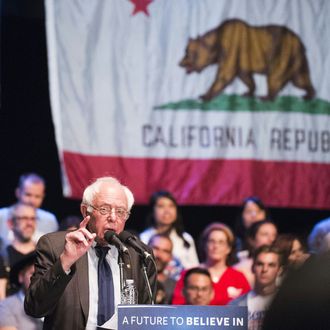
For the first time in decades (with the exception of 2008, when the state moved its traditional June presidential primary up to February), California’s late presidential primary is going to matter, perhaps in both parties. It’s looking less and less likely that Donald Trump is going to reach the 1,237 delegates he needs for the Republican nomination before June 7, and California may well confirm that the GOP is heading toward a contested convention. On the Democratic side, it’s less likely that Bernie Sanders will be within striking distance of Hillary Clinton’s lead in pledged delegates by June 7 (and edging her in pledged delegates is the only way he can chip away significantly at her giant lead in superdelegates and thus overall delegates). If he is, the gains he seems to be making on Clinton in California need to turn into a big and steady trend in his favor.
The highly respected Field Poll issued a new survey of the Democratic presidential contest Friday, and it showed the 11-point (46-35) lead Clinton enjoyed at year’s end declining to 6 points (47-41) today.
Before digging into the findings, it’s important to understand some peculiarities about the California primary.
First of all, Democrats, but not Republicans, have decided to open their process to independents this year. That’s of obvious importance to Bernie Sanders. According to Field, a little over a fourth of Democratic-likely voters will be independents — a group Sanders has been winning by a large margin.
Second of all, California is a state with relatively heavy voting by mail, driven in part by the option of permanent voting-by-mail registration; those who so register automatically receive a ballot about a month from the election so long as they keep voting. In the 2014 statewide primary, 69 percent of votes were cast by mail. This means the “campaign” in California will begin much earlier than June.
And third of all, the presidential primary will coincide with the state’s top-two primary for all non-presidential offices. Instituted by a ballot initiative in 2010, the top-two system abolished party primaries for non-presidential contests altogether, substituting a “jungle primary” where everyone competes for two spots in the November general election. Unlike Louisiana’s version of the “jungle primary,” a majority in the first round does not enable a candidate to avoid the second. As intended, the system has produced some two-Democrat and two-Republican general-election contests that reward candidates who can win crossover votes. But against its proponents’ expectations, top-two, so far at least, has not boosted primary turnout; in June 2014, turnout dropped to an all-time low of 25 percent.
It also seems Republican voters are more likely than Democrats to show up in the top-two system. There have been some fears that the GOP presidential primary will accentuate this tendency, thanks to the hype surrounding the Trump/Cruz contest. For that reason, even some Clinton supporters may hope for a tight presidential race to get Democrats out.
On the other hand, the marquee non-presidential race in California, the contest to choose a successor to Senator Barbara Boxer, is looking like an all-Democratic affair featuring Attorney General Kamala Harris, a San Francisco–based African-American woman, and Representative Loretta Sanchez, a Los Angeles–based Latina. In theory, high primary turnout should enable Republicans to sneak a candidate into the general election, but so far, their candidates are too numerous and too obscure to challenge the Democrats. One much-discussed scenario is that Sanchez, long associated with centrist New Democrats, could beat the more rigorously liberal Harris in November by appealing to business groups and Republicans.
For the purposes of June 7, though, it’s not clear whether this or other down-ballot races will have any effect on the presidential contest. Both Sanchez and Harris have endorsed Clinton, who, according to the Field Poll, is leading both in San Francisco and in L.A. County.
The most interesting numbers in the Field Poll involve both demography and geography. It shows HRC leading Sanders among Latinos by a spare 49-42 margin, and among African-Americans by a much stronger, but hardly Mississippi-level, 64-25. Sanders gets his customarily massive 77 percent among under-30 voters, though his margin among independents is a lower-than-usual ten points (49-39). The two candidates are running near-even in the more affluent and (usually) more politically mobilized coastal counties, and much of HRC’s statewide lead is from inland counties. If California is going to wind up feeling the Bern, it will probably emanate from the heart of the Left Coast. The question we cannot answer right now is whether it would matter if he narrowly won.
California has, on occasion, offered a late protest vote against putative Democratic nominees, going for Ted Kennedy in 1980 and Gary Hart in 1984. That’s part of the state’s late-primary legacy of not really having a say about presidential nominations. As a California voter, I can tell you there’s a sense of excitement about the presidential contest in the Golden State that’s been missing for a quite awhile. We’ll soon see if it’s long gone or going strong by June 7.






























